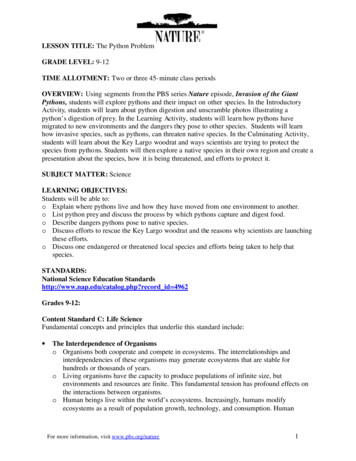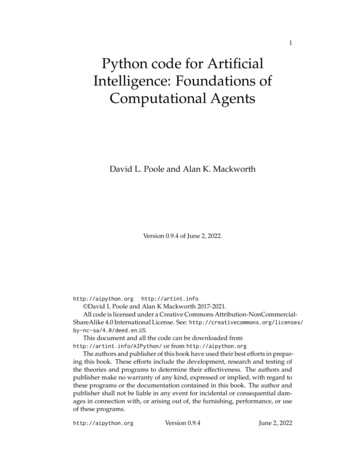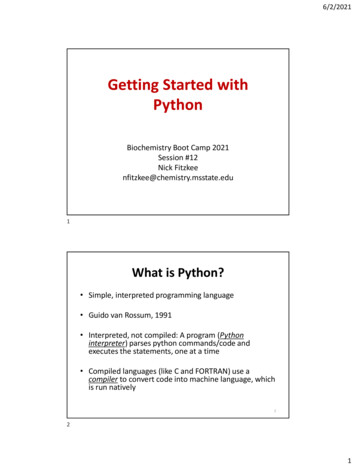
Transcription
LESSON TITLE: The Python ProblemGRADE LEVEL: 9-12TIME ALLOTMENT: Two or three 45- minute class periodsOVERVIEW: Using segments from the PBS series Nature episode, Invasion of the GiantPythons, students will explore pythons and their impact on other species. In the IntroductoryActivity, students will learn about python digestion and unscramble photos illustrating apython’s digestion of prey. In the Learning Activity, students will learn how pythons havemigrated to new environments and the dangers they pose to other species. Students will learnhow invasive species, such as pythons, can threaten native species. In the Culminating Activity,students will learn about the Key Largo woodrat and ways scientists are trying to protect thespecies from pytho ns. Students will then explore a native species in their own region and create apresentation about the species, how it is being threatened, and efforts to protect it.SUBJECT MATTER: ScienceLEARNING OBJECTIVES:Students will be able to:o Explain where pythons live and how they have moved from one environment to another.o List python prey and discuss the process by which pythons capture and digest food.o Describe dangers pythons pose to native species.o Discuss efforts to rescue the Key Largo woodrat and the reasons why scientists are launchingthese efforts.o Discuss one endangered or threatened local species and efforts being taken to help thatspecies.STANDARDS:National Science Education Standardshttp://www.nap.edu/catalog.php?record id 4962Grades 9-12:Content Standard C: Life ScienceFundamental concepts and principles that underlie this standard include: The Interdependence of Organismso Organisms both cooperate and compete in ecosystems. The interrelationships andinterdependencies of these organisms may generate ecosystems that are stable forhundreds or thousands of years.o Living organisms have the capacity to produce populations of infinite size, butenvironments and resources are finite. This fundamental tension has profound effects onthe interactions between organisms.o Human beings live within the world’s ecosystems. Increasingly, humans modifyecosystems as a result of population growth, technology, and consumption. HumanFor more information, visit www.pbs.org/nature1
destruction of habitats through direct harvesting, pollution, atmospheric changes, andother factors is threatening current global stability, and if not addressed, ecosystems willbe irreversibly affected.MEDIA COMPONENTSInvasion of the Giant Pythons, selected segmentsClip 1: Dinner TimeAn overview of how a python captures and digests its prey.Clip 2: It’s Raining PythonsA close look at how pythons have entered new environmentsClip 3: Beware: PythonsA description of the dangers that pytho ns pose to other species.Clip 4: Saving the RatsA look at efforts to protect the Key Largo woodrat from pythons.Websiteso Invasion of the Giant Pythons/ Photos:These pages on the Nature website illustrate the process by which a python digests its prey.These images can be used in the Introductory Activity. Python digesting an nvasion-of-the- 5547/ Python digesting a n-of-the- giant-pythons/photos-pythondigesting-a-rat/5554/o US Fish and Wildlife Endangered Species Programhttp://www.fws.gov/endangered/This website includes a variety of information about endangered species. The “SpeciesSearch” page (http://www.fws.gov/endangered/species/), used in the Culminating Activity,features a US map where visitors can locate endangered plant and animal species throughoutthe country.Optional (for research in Culminating Activity):o The Comprehensive Everglades Restoration Planhttp://www.evergladesplan.org/index.aspxThis website includes a variety of information about the Everglades, including facts aboutplants and animals: http://www.evergladesplan.org/facts info/sywtkma animals.aspxFor more information, visit www.pbs.org/nature2
o California Department of Fish and Game/ Invasive Species Programhttp://www.dfg.ca.gov/invasives/This website contains information about invasive species in California and efforts beingtaken to reduce their negative effects on native species and environments.o South Florida Natural Resources Center/ Everglades National Park: Natural ResourcesManagement/ Burmese d/PythonFactSheetHiRes.pdfThis fact sheet provides detailed information about Burmese pythons and efforts underway tomonitor and control the python population.MATERIALSFor the class:o Computers with internet accesso Computer, projection screen and speakers (for class viewing of online/downloaded videosegments)o One copy of the “Python Digestion Game Answer Key” (download here)For each pair of studentso 1 copy of the “Python Digestion Game” (download here)PREP FOR TEACHERSPrior to teaching this lesson, you will need to:Preview all of the video segments and websites used in the lesson.Download the video clips used in the lesson to your classroom computer(s) or prepare to watchthem using your classroom’s Internet connection.Bookmark any websites that you plan to use in the lesson on each computer in your classroom.Using a social bookmarking tool such as del.icio.us or diigo (or an online bookmarking utilitysuch as portaportal) will allow you to organize all the links in a central location.Print out one copy of the “Python Digestion Game” for each pair of students. If desired, cut thecards along the dotted lines prior to the class and paper clip each set of 6 cards together. If youdo not pre-cut the cards, provide students with scissors to cut out the cards themselves.Print out one copy of the “Python Digestion Game Answer Key.”INTRODUCTORY ACTIVITY1. Explain that during this lesson, students will be learning about pythons and the threats theyand other non-native species pose to native species. Ask students to brainstorm what theyknow about pythons. Write down students’ answers in a central location where the class canreview them later. (During the discussion, ask students whether or not they think pythons arepoisonous. Ask students to brainstorm how they think pythons get from one environment toFor more information, visit www.pbs.org/nature3
another, as well as to hypothesize what they think pythons eat.)2. Distribute the “Python Digestion Game Cards.” Explain these cards illustrate the process bywhich a python digests an animal. Challenge students to place the cards in order from the 1stday after feeding to the 6th day after feeding, and to identify the animal being digested.3. Once the students have finished the task, ask students what animal is being digested. (Analligator.) Using the “Python Digestion Game Answer Key,” reveal the order of the photosfrom the 1st day after feeding to the 6th day after feeding. [Correct Order: C (1 day afterfeeding), A (2 days after feeding), E (3 days after feeding), B (4 days after feeding), F (5 daysafter feeding), D (6 days after feeding).] If desired, project the following page on a screen toillustrate the correct order to nvasion-of-the- 5547/4. Optional: Project the following images of an alligator digesting a rat and discuss them withthe students: 554/5. FRAME Video Segment #1 “Dinner Time,” explaining that the students will now see a videosegment illustrating the process by which a python captures and digests prey. Provide aFOCUS, asking students to observe the process by which the python digests its food.6. PLAY Clip #1. After playing the clip, FOLLOW UP by asking students to describe theprocess by which the python digests its food. (The python uses powerful stomach acidshydrochloric acid and the enzyme pepsin- to completely dissolve a meal. The prey is passedfrom the esophagus to the stomach. After the meal has been broken down in the stomach, theremains are passed along to the small intestine. It takes about 6 days for a python tocompletely digest an alligator or a rat.).7. Review the list that the class compiled earlier about the python. Modify the list based on theinformation learned in this clip. (Some information to include in the list: The python is notpoisonous. Pythons eat a variety of prey, including alligators, mice, rats, squirrels, rabbitsand raccoons.)LEARNING ACTIVITY1. FRAME Clip #2, “It’s Raining Pythons” by explaining that pythons are originally from Asia,but now there are thousands of pythons in Florida. Ask students to brainstorm how they thinksnakes might have ended up in Florida. (Accept all answers.)2. Provide a FOCUS for Clip #2 by asking students to list two factors contributing to theincreased number of pythons in Florida.3. PLAY Clip #2. After the segment, FOLLOW UP, by asking students to list factors that havecontributed to the increased number of pythons in Florida.Possible answers:For more information, visit www.pbs.org/nature4
o Pythons have arrived in Florida, via airplane, including 140,000 wild caught pythonsshipped to Florida within the last 4 years.o People who had pythons as pets have released them into the wild.o Snakes have escaped from animal warehouses when the warehouses were hit byhurricanes.o Snakes have used the waterways in Florida as a means to travel to migrate to the interiorof the state.4. Ask students to brainstorm how this invasion of pythons might impact species native toFlorida. (Accept all answers.)5. FRAME Clip #3: “Beware: Pythons,” by telling students the next video segment illustratessome of the threats pythons pose to native animals. Provide a FOCUS by asking students tofind at least three dangers pythons pose to other species.6. PLAY Clip #3. After the segment, FOLLOW UP with a discussion of the threats pythonspose to native species. (Include the following information in the discussion: Pythons providecompetition with native animals for food and space. They can spread disease and providesafety dangers to humans.)7. Ask students to review the list they compiled earlier and revise it to include additionalinformation that they now know about pythons. (Items to include: Pythons are originallyfrom Asia and have been released into the wild in the US by humans and by storms. Pythonscan eat almost any animal, including pigs, rodents, deer, bobcats and birds.)CULMINATING ACTIVITY1. FRAME the next clip by explaining that there are a variety of native species that could beendangered by the increased presence of pythons. One of the species at risk is the Key Largowoodrat. Provide a FOCUS for the next clip, by asking students to observe efforts underwayto protect the Key Largo woodrat from pythons.2. Play Clip #4 “Saving the Rats.” After showing the segment, FOLLOW UP by askingstudents to describe current efforts to protect the Key Largo woodrat from pythons. Possibleanswers: Traps: There is a network of more than 60 traps across Key Largo to trap pythonsarriving from the mainland. Each trap includes a rat, which serves as a lure for thepythons. The python approaches, smells the rat, enters the cage and the flaps closebehind it to prevent it from escaping. The python can’t get to the rat from within the trap.The trap is checked daily and trapped pythons are removed. Native animals, includingnative snakes, can exit through escape hatches. No pythons have been caught yet. Breeding program: Disney’s Animal Kingdom and Tampa’s Lowry Park Zoo havecreated a breeding program to increase the woodrat population.3. Ask students why people are trying to save the woodrat. (The Florida Keys is the only hometo the Key Largo woodrat. The woodrat was first listed as threatened in 1969. Its populationFor more information, visit www.pbs.org/nature5
has decreased since then. Currently, fewer than 200 woodrats live in the wild.)4. Explain that in the final activity for this the lesson, students will find out more about localendangered species.5. Demonstrate how to use the US Fish and Wildlife Endangered Species Program’s “SpeciesSearch” map by doing the following: Display the map: http://www.fws.gov/endangered/species/ Click on a state. Scroll down the page to the lists of species. Click on one of the species labeled “E”(Endangered) or “T” (Threatened) to display additional information about that species.6. Divide students into pairs and ask each pair to use the “Species Search” map to select a state(it’s fine for all students to select the same state). Ask each pair to explore the list ofthreatened and endangered species and to select one species. Ask students to conductresearch about that species using a variety of print and online resources. Based on theirresearch, students will create a presentation about the species, including basic informationabout the species and its native habitat, why it is threatened or endangered and steps, if any,being taken to protect the species.7. Ask students to present their findings to the group. Lead a discussion about the variousspecies the students have researched and current efforts being taken to protectthreatened/endangered species.For more information, visit www.pbs.org/nature6
Python Digestion GameThese images show a python digesting an animal over a six-day period. Cut out the cards below and see if you can place them in the right order and identify the animal.ABCDEF
Python Digestion Game : ANSWER KEYThese images show a python digesting an alligator over a six-day period. The cards below are in scrambled order. See bottom of page for correct order.ABCDEFCorrect Answers:One day after feedingTwo days after feedingThree days after feedingFour days after feedingFive days after feedingSix days after feedingCAEBFD
another, as well as to hypothesize what they think pythons eat.) 2. Distribute the “Python Digestion Game Cards.” Explain these cards illustrate the process by which a python digests an animal. Challenge students to place the cards in order from the 1st day after feeding to the 6th day











